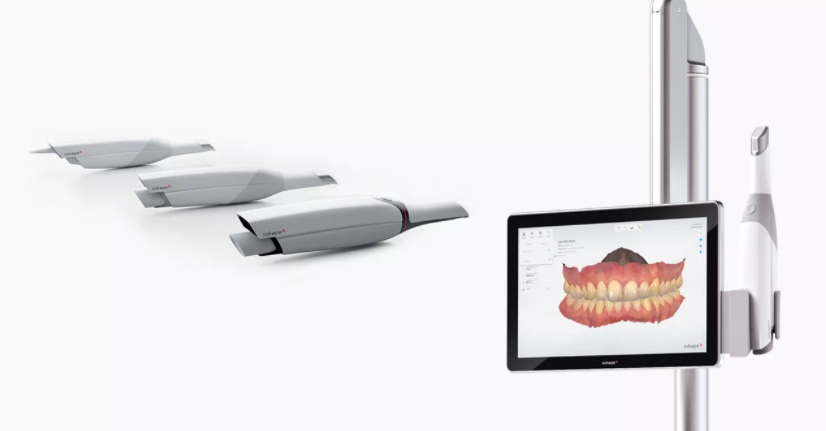 With COVID-19 changing the way many practise dentistry, 3shape questions whether digital impression taking is safer than analogue.
With COVID-19 changing the way many practise dentistry, 3shape questions whether digital impression taking is safer than analogue.
In a hygiene and safety-conscious industry, COVID-19 has pushed the subject even higher up the agenda. Consequently, what does independent research tell us about digital and analogue impression taking and dental hygiene and safety?
1. With analogue impressions your workflow needs extra steps
Traditional impression techniques require handling multiple items. Including the tray, chewing waxes, impression materials and also any associated appliances. These handling factors are however, eliminated with digital impressions (Barenghi et al, 2019).
Conventional impressions/casts that are transferred to a lab involve transportation, which also increases the risk of cross-infection (Sofou et al, 2002; Vazquez-Rodrıguez et al, 2018). They can involve many hours in potentially humid conditions. Digital impressions with Trios do not require any physical transportation from clinic to the lab.
2. Conventional impressions are challenging to disinfect. Digital scans require no disinfection
A wide variety of chemical solutions and techniques are recommended to disinfect impression materials (Mushtaq and Khan, 2018; Chidambaranathan and Balasubramanium, 2019).
Getting the Trios ready for use includes thorough cleaning and disinfection between patients. This also includes a strict protocol to clean and disinfect the scanner body and autoclaving the scanner tips. It therefore ensures proper disinfection between uses.
3. Conventional impression and cast handling between lab and clinic can increase cross-infection risks
Dental lab employees are at risk of infection from soiled impressions received from dental clinics. Contaminated items returned from dental labs to dental clinics can also become a source of cross-infection (Verran, Kossar and McCord, 1996; Sykes et al, 2019).
Conventional impressions from clinics have to be disinfected by labs to ensure the set dental cast does not contain microorganisms. These can also percolate within the material and remain viable for up to a week (British Dental Association, 2013; Sammy and Benjamin, 2016).
Using digital impressions significantly lowers the risk of cross-infection since there is no cast handling.
4. Manual creation of appliances/restorations increases contamination risks in the lab
Traditional production of dental restorations/appliances provides additional opportunities for contamination (Barker et al, 2014). Therefore, they require disinfecting, which extends the processing time.
Digital design solutions require significantly reduced handling (Suese, 2020; Ambili and Prasad, 2019). Furthermore, increased automation in dental appliance production processes require little or no human intervention (Rekow, 2020).
Speak to our specialists, request a demo or take advantage of our exclusive summer offer on all Trios models here.
References
Ambili C and Prasad B (2019) The era of future dentistry: Recent advances and future perspectives of restorative dentistry: A literature review. Int J Appl Dent Sci 5: 111-6
Barenghi L, Barenghi A, Cadeo C and Di Blasio A (2019) Innovation by Computer-Aided Design/Computer-Aided Manufacturing Technology: A Look at Infection Prevention in Dental Settings. Biomed Res Int Aug 6; 6092018
Barker CS, Soro V, Dymock D, Sandy JR and Ireland AJ (2014) Microbial contamination of laboratory constructed removable orthodontic appliances. Clin Oral Invest 18: 2193-202
British Dental Association (2013) Health Technical Memorandum 01-05: Decontamination in Primary Care Dental Practices. London: Department of Health
Chidambaranathan A and Balasubramanium M (2019) Comprehensive Review and Comparison of the Disinfection Techniques Currently Available in the Literature. J Prosthodont 28(2): e849-56
Mushtaq MA and Khan MWU (2018) An overview of dental impression disinfection techniques: a literature review. J Pak Dent Assoc 27(4): 207-12
Rekow ED (2020) Digital dentistry: The new state of the art — Is it disruptive or destructive? Dent Mat 36 (1): 9-24
Sammy K and Benjamin S (2016) Infection control mechanisms employed by dental laboratories to prevent infection of their dental technicians/technologists. J Oral Health and Craniofacial Science 1(1): 001-011
Suese K (2020) Progress in digital dentistry: The practical use of intraoral scanners. Dent Mater J 39(1): 52-6
Sofou A, Larsen T, Fiehn N and Öwall B (2002) Contamination level of alginate impressions arriving at a dental laboratory. Clin Oral Invest 6: 161–5
Sykes LM, Said M, Ehlers M, Mateis SM, van Dyk C and Dullabh HD (2019) Microbial contamination of denture polishing equipment. S Afr Dent J 74(3): 116-22
Vazquez-Rodrıguez I, Estany-Gestal A, Seoane-Romero J, Mora M, Varela-Centelles P and Santana-Mora U (2018) Quality of cross-infection control in dental laboratories. A critical systematic review. Int J Quality in Health Care 30 (7): 496–507
Verran J, Kossar S and McCord JF (1996) Microbiological study of selected risk areas in dental technology laboratories. J Dent 24: 77-80


